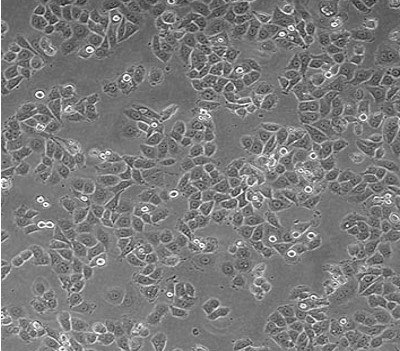Table 4.1. Cell culture reagents used.
Aim, materials and methods – Cytotoxicity evaluation (MTT test) – EPSAN® C
AIM
The purpose of the test is to evaluate the cytotoxicity of the product EPSAN® C following the UNI EN ISO 10993-5 modified standard concerning the biological evaluation of medical devices.
The cytotoxicity assay performed in this study was designed to evaluate the cytotoxic potential of tested product towards fibroblasts through the MTT test.
MATERIALS AND METHODS
Cell culture The keratinocytes used in the assay were a human cell line (HaCaT, BS code CL 168), provided by I.Z.L.E.R. (Istituto Zooprofilattico della Lombardia e Emilia Romagna) (Figure 4.1.).
The cell line was grown in complete culture medium (Table 4.1.) in condition of complete sterility and maintained in incubation at 37 °C with an atmosphere of 5% carbon dioxide (CO2).

Figure 4.1. Representative image of HaCaT cell line.
| Reagents | Company | Code – Batch |
| Dulbecco’s Modified Eagle’s Medium (DMEM) High Glucose | Euroclone |
ECM0101L – EUM00AH
|
| L-glutammine solution | Euroclone |
ECB3000D – EUM0092
|
| Penicillin – Streptomicyn | Euroclone |
ECB3001D – EUM008U
|
| Fetal Bovine Serum (FBS) | Euroclone |
ECS0180D – EUS00F1
|
The product EPSAN® C was dissolved at the concentration of 3% in cell culture medium with 10% of fetal bovine serum (FBS).
Treatment and cytotoxicity assay
MTT test is a colorimetric cytotoxicity assay used to test cell proliferation and viability based on mitochondrial efficiency. MTT (3-(4,5-dimethylthiazol-2-yl)-2,5-diphenyl tetrazolium bromide) is a tetrazolium salt that, in case of viable cells, is reduced from the highly reducing mitochondrial environment of viable cells by the action of mitochondrial dehydrogenase. MTT reduction leads to the formation of formazan crystals, insoluble in the culture medium but soluble in isopropanol, which gives the typical purple colour to the mitochondria of viable cells. In contrast, in suffering or dead cells, lacking active mitochondria, MTT will not be reduced resulting in a less intense purple colour.
For the direct relationship between respiration and viability, MTT is considered a good assay to evaluate cell viability (Mosman, 1983). For the preparation of the assay, cells were homogeneously seeded in 96-well plates and incubated at 37 °C, with 5% CO2 humidified atmosphere. After 24 h, cells were treated with the tested product with 8 scalar dilutions ranging from 0.023% to 3%. Cells treated with a known irritating surfactant (SLS) were used as positive control (in concentration from 0.0039% to 0.5%). Untreated cells were used as negative control. The product and positive control were dissolved and diluted in medium.
The test was carried out in 3 replicates for each dilution. After 24 h of treatment, cells were examined under a phase-contrast microscope to record chenges in morphology, possibly due to cytotoxic effects of the tested product. Then the culture medium was removed and the cells were incubated with the MTT solution (1 mg/ml) at 37 °C for 2 h. Subsequently the solution was removed, replaced with 100 µl of isopropanol and the absorbance was read at a
570 nm wavelength using a microplate reader. Cell survival was calculated measuring the difference in optical density of the tested product with respect to the negative control (untreated cells) (Van Meerloo et al., 2011).
Quality check of the assay and expression of results
// Positive control
SLS is one of the most frequently positive control tested, based on history of intra- and interlaboratory repeated test, and therefore it is recommended as a positive control.
// Negative control
Negative control is represented by the culture medium without the tested product. The use of a negative control in a toxicity test allows to evaluate the possible aspecific effects of reagents and dye.
A test meets the criteria if the mean of the OD570 of negative controls is ≥ 0.2 and if the left and right mean of the negative controls do not differ by more than 15% from the mean of all negative controls.
// Expression of results
The results are expressed in terms of viability:
Cell viability (%) = [OD(570nm) test product/OD(570nm) negative control] x 100
Reduction of cell viability by more than 30% is considered a cytotoxic effect.
In that case, it is possible to calculate the IC50 value, which indicates the concentration of test product which inhibits the cell viability of 50%.
